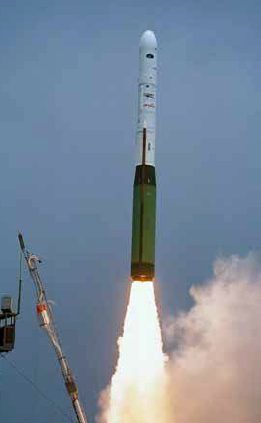
Home - Search - Browse - Alphabetic Index: 0- 1- 2- 3- 4- 5- 6- 7- 8- 9
A- B- C- D- E- F- G- H- I- J- K- L- M- N- O- P- Q- R- S- T- U- V- W- X- Y- Z
Minotaur
 Minotaur Credit: OSC |
Status: Active. Payload: 640 kg (1,410 lb). Thrust: 720.00 kN (161,860 lbf). Gross mass: 36,200 kg (79,800 lb). Height: 19.21 m (63.02 ft). Diameter: 1.67 m (5.47 ft). Apogee: 185 km (114 mi).
The Minuteman motors served as the vehicle's first and second stages. Minotaur's third and fourth stages, structures and payload fairing were taken directly from Orbital's existing Pegasus XL rocket. Its capabilities were enhanced with the addition of improved avionics systems, including a Modular Avionics Control Hardware (MACH), already used on many of Orbital's suborbital launch vehicles.
Minotaur made its inaugural flight in January 2000, successfully delivering a number of small military and university satellites into orbit and marking the first-use of surplus Minuteman boosters in a space launch.
Several derivatives of Minotaur were developed or proposed:
- Minotaur I (the original Minotaur), consisting of an M55A1 first stage, SR19 second stage, Orion 50XL third stage, Orion 38 fourth stage, and optional HAPS fifth stage for velocity trim and multiple payload deployment. Payload 580 kg to an 185 km, 28.5 degree orbit from Cape Canaveral; 310 kg to a 740 km sun-synchronous orbit from Vandenberg.
- Minotaur II (a suborbital target vehicle), consisting of an M55A1 first stage, SR19 second stage, and M57 third stage - essentially a Minuteman II with Orbital guidance and control systems. 440 kg payload on a 6700 km suborbital trajectory.
- Minotaur III (a suborbital target vehicle), using surplus Peacekeeper rocket stages, with an SR-118 first stage, SR-119 second stage, SR-120 third stage, and Super HAPS fourth stage. 3060 kg payload on a 6700 km suborbital trajectory.
- Minotaur IV (space launch vehicle), as Minotaur III but with an Orion 38 fourth stage and optional HAPS fifth stage. Payload 1720 kg to an 185 km, 28.5 degree orbit from Cape Canaveral; 1000 kg to a 740 km sun-synchronous orbit from Vandenberg.
- Minotaur V (space launch vehicle for putting small spacecraft on high-energy trajectories, such as GTO, HEO, and lunar), as Minotaur IV but with a Star 48V fourth stage and Orion 38 fifth stage. Payload 560 kg to a geosynchronous transfer orbit.
All of the Minotaur-family launches to date have been from Vandenberg AFB, CA. Minotaur I launches were from Space Launch Complex 8 (SLC-8), the Spaceport Systems Incorporated (SSI) Commercial Launch Facility (CLF). Minotaur II launches have all been from Launch Facility 06 (LF-06).
LEO Payload: 640 kg (1,410 lb) to a 185 km orbit at 28.50 degrees. Payload: 335 kg (738 lb) to a 741 km SSO. Recurring Price $: 12.500 million in 1999 dollars.
Stage Data - Minotaur
- Stage 1. 1 x Minuteman-1. Gross Mass: 23,077 kg (50,876 lb). Empty Mass: 2,292 kg (5,052 lb). Thrust (vac): 791.300 kN (177,891 lbf). Isp: 262 sec. Burn time: 60 sec. Isp(sl): 237 sec. Diameter: 1.67 m (5.47 ft). Span: 1.67 m (5.47 ft). Length: 7.49 m (24.57 ft). Propellants: Solid. No Engines: 1. Engine: M55/TX-55/Tu-122. Status: Out of Production. Comments: First stage of Minuteman I. Proposed as zero stage for various Saturn variants in 1960's. Surplus motors used in ABM SDI tests in 1980's and 1990's.
- Stage 2. 1 x Minuteman 2-2. Gross Mass: 7,032 kg (15,502 lb). Empty Mass: 795 kg (1,752 lb). Thrust (vac): 267.700 kN (60,181 lbf). Isp: 288 sec. Burn time: 66 sec. Diameter: 1.33 m (4.36 ft). Span: 1.33 m (4.36 ft). Length: 4.12 m (13.51 ft). Propellants: Solid. No Engines: 1. Engine: SR-19. Status: Out of production. Comments: Second stage of Minuteman 2. Used as second stage of Minotaur launch vehicle and various SDI targets in 1980's.
- Stage 3. 1 x Pegasus XL-2. Gross Mass: 4,331 kg (9,548 lb). Empty Mass: 416 kg (917 lb). Thrust (vac): 153.503 kN (34,509 lbf). Isp: 290 sec. Burn time: 73 sec. Isp(sl): 240 sec. Diameter: 1.27 m (4.16 ft). Span: 1.27 m (4.16 ft). Length: 3.58 m (11.74 ft). Propellants: Solid. No Engines: 1. Engine: Pegasus XL-2. Status: In Production.
- Stage 4. 1 x Pegasus-3. Gross Mass: 985 kg (2,171 lb). Empty Mass: 203 kg (447 lb). Thrust (vac): 34.568 kN (7,771 lbf). Isp: 293 sec. Burn time: 65 sec. Isp(sl): 240 sec. Diameter: 0.97 m (3.18 ft). Span: 0.97 m (3.18 ft). Length: 2.08 m (6.82 ft). Propellants: Solid. No Engines: 1. Engine: Pegasus-3. Status: In Production.
More at: Minotaur.
Family: all-solid, orbital launch vehicle. Country: USA. Spacecraft: Microstar, MightySat 1, ASUSAT, JAK, JAWSAT, MEMS, OCSE, OPAL, STENSAT, SA-200, Picosat, XSS, USA 185, Genesat, Tacsat ORS. Agency: OSC. Bibliography: 2, 426, 455, 552, 554.
Back to top of page
Home - Search - Browse - Alphabetic Index: 0- 1- 2- 3- 4- 5- 6- 7- 8- 9
A- B- C- D- E- F- G- H- I- J- K- L- M- N- O- P- Q- R- S- T- U- V- W- X- Y- Z
© 1997-2019 Mark Wade - Contact
© / Conditions for Use